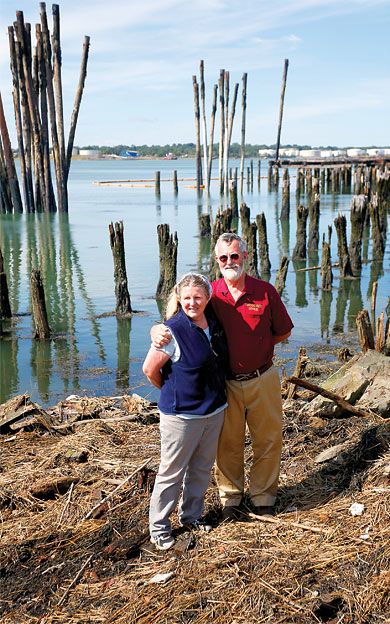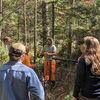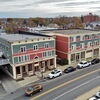Phineas Sprague discusses his Portland waterfront plans
 PHOTo / Tim greenway
Phineas Sprague Jr. and his wife, Joanna, at the future site of their new boat yard off West Commercial Street in Portland.
PHOTo / Tim greenway
Phineas Sprague Jr. and his wife, Joanna, at the future site of their new boat yard off West Commercial Street in Portland.
Two corner pieces of the puzzle snapped into place for Portland’s waterfront this summer when Phineas Sprague Jr. sold his 10-acre Portland Co. Marine Complex on the eastern end in late July, and then closed the following week on separate purchase and lease agreements for 23 acres on West Commercial Street, where he plans to relocate his Portland Yacht Services boatyard.
Since 2002 Portland’s eastern waterfront master plan has envisioned a mix of uses in the sprawling Portland Co. Marine Complex at 58 Fore St. That vision took a big step forward when Phineas Sprague Jr. sold the property — valued by the city at almost $1.9 million — for an undisclosed price to a Yarmouth-based development company, CPB2, led by Jim Brady and Casey Prentice. That sale helps leverage Sprague’s plans to relocate his 40-employee boatyard from Fore Street to vacant land at 40 West Commercial St., adjacent to the International Marine Terminal and the Casco Bay Bridge. On Aug. 27, Sprague announced he is buying Gowen Marine, located at 400 Commercial St. and slightly east of that property. He expects that sale to go through by late September and says it will facilitate his long-term plans to relocate and expand his boatyard.
Sprague recently sat down with Mainebiz at his third-floor office overlooking the Fore Street marina and explained how those real estate transactions are critical links in the city’s vision for both its working and commercial waterfront zones. An edited transcript follows.
Mainebiz: Was the sale of the 10-acre Portland Co. Marine Complex on the eastern waterfront in late July the catalyst for your purchase and the lease agreements on the 23 acres at 40 West Commercial St. in early August?
Phineas Sprague Jr.: New businesses need old buildings; old businesses need new buildings. So we’ve transitioned to the place where an old business, Portland Yacht Services Inc., with 40 employees, has desperately run out of space here and needs new space.
I’m standing on the shoulders of a lot of people who have helped me get to the place where we finally have a mature business that we can afford to move into new digs, and where the buildings at Portland Co. Marine Complex are a higher and better use for something else. The new digs, the new boatyard, really advances an overall plan of the city that has been like a fruit tree in which the seed was planted 20 or 30 years ago. Finally, in a very short period of time, you realize it’s ripe to be plucked.
If you step back, this was a really complex charge to give to Tony McDonald at CBRE|The Boulos Co. I was not going to sell this property unless I had a place for my guys – my employees at Portland Yacht Services. So the first step was to identify a place where we could move the boatyard. In fact, our purchase-and-sales agreement said if we don’t have that place we’re not selling the property.
MB: That’s a tall order.
PS: Right. He had to find a buyer who was sensitive enough to the community to understand the importance of the historic buildings here and build it into a plan. … We really lucked out, I think, in selling to Jim Brady and Casey Prentice, who were really local. They share the vision of what this can be. So I’m blessed that we could pull it together. … I had to get the planets all lined up so we could shoot it with one bullet.
MB: What about the separate purchase and lease agreements you closed in early August to secure the 23 acres you need for your boatyard relocation and expansion on West Commercial Street?
PS: My grandfather was chairman of the board of Maine Central Railroad -- so I have a great appreciation of how hard it is for the railroads to run, with a very small office, a business that goes through every town in this state. I really appreciate Pan Am Railways’ willingness to talk to me about buying their property. I think [they] shared my vision and really wanted to see this happen.
At the same time, we were able to talk to Unitil. When you talk about the planets lining up: I’m a geologist and I was on the Casco Bay Estuary board. I knew about the pollution issue over at the Unitil site. I was willing to take a risk because I believe that between the Maine Department of Environmental Protection, the people representing Unitil and the people at Credere Associates who have been helping me, we were all willing to take the leap of faith -- i.e., that we were smart enough to figure it out. …
Meanwhile, all the lawyers were saying ‘Don’t do it!’ But I decided to take the leap and say, ‘I want this property for my boatyard and my guys and I think we can do this together as a team.’ I think the people at Unitil, as well, signed onto the vision and said ‘We can do this.’
MB: Are you referring, now, to the leased 9-acre portion of the 23 acres at 40 West Commercial St.?
PS: Yes. We purchased 14 acres from the railroad, and nobody would let me buy the 9 acres that belong to Unitil until such time as we are really sure the remediation has been successful.
MB: So, is it a lease with an option to buy?
PS: Yes. It’s essentially, for tax purposes and all other things, a purchase. But because of legal complexities, the lease protects me [during] the remediation that is going to take place there and which I believe will be successful.
MB: Is the Unitil parcel what is sometimes referred to as a ‘brownfield’ site?
PS: It’s called a ‘Voluntary Remediation Action Plan.’ I don’t know what the definition of a ‘brownfield’ is, so I’m not sure I want to use that phrase as a description. These are places where there are known issues because of historic industries that were there that require remediation. And we because we’ve pulled the three parcels together, Unitil can now address those to the satisfaction of Maine’s DEP. It’s really a win-win in all respects.
MB: So you needed DEP’s input in order to be sure this was do-able? In other words, if DEP was indicating it wouldn’t be possible, then all of these transactions would not have been able to fall into place?
PS: Right.
In the process of getting all of our permits, I couldn’t buy the property until I knew I could put a boatyard there. So the ‘trigger’ was the last permit, and the last permit was the Army Corps of Engineers. At the point where we got all the permits, then I had an obligation to close. And because the planets lined up I was able to close first on the Portland Co. Marine Complex property and use the funds from that to acquire the other property.
MB: This all took place in early August?
PS: The conclusion of it was in early August.
This never would have happened if not for Norway Savings Bank. The backup plan was the fact that in April, Norway Savings Bank committed to us -- regardless of whether this deal went through or not --they would finance the new yard. Norway Savings Bank was essential in allowing me to have the courage to move forward regardless of whether the CPB2 principals could move ahead with their purchase [of the Portland Co. Marine Complex].
MB: But why move a well-established boatyard from the eastern to the western waterfront?
PS: The community has spoken on this property [the Portland Co. Marine Complex] on what they would like to see here: The Eastern Waterfront Master Plan. That dialogue brought me to the conclusion that there was no way the boatyard was the highest and best use of this property. I realized I should be looking for another place to go. The arrows that the community had set up pointed to west of the bridge. … I was looking for a place for the next generation where a boatyard could exist and compete.
It’s satisfying a need. If we want Portland to resonate as a commercial harbor, as well as yachting harbor, there needs to be a place to take care of these boats.
MB: Commercial, meaning tugs?
PS: Tugs, barges, fishing boats, tending vessels. That element here, although it’s represented now by very small entities, it’s not really being fulfilled. So our vision is to fill that niche.
MB: How do your plans for a boatyard on West Commercial Street fit in with Portland’s overall vision for the waterfront?
PS: The foundation for the West Commercial Street boatyard was set in the 1980s, when the waterfront alliance had a huge discussion about how do you preserve the working waterfront of Portland? The rapid utilization of the historic waterfront by non-marine-related uses [at that time] alarmed people.
The community really had, if you will, a drag-down drag-out fight over what it saw as the vision of the Portland waterfront. The issue was that we needed to preserve the working component of the waterfront. The community set aside 29 acres west of the bridge for a use that had not even existed at the time. ...The foundation for this move, then, was the community dialogue on what was going to happen there [on the western waterfront].
MB: In what other ways might the West Commercial Street land be better suited for an expanded boatyard than at Fore Street?
PS: Well, I love these buildings [at Portland Co. Marine Complex]. But these building aren’t appropriate for storing boats in. They’ve got pillars all through them. You can’t be efficient. They need a higher revenue stream than storing boats can provide. I need buildings that are functional. These building are historically significant and not on my watch will they be torn down to build an architecturally bland warehouse.
MB: So the advantage of moving to a vacant site is …?
PS: You can start from scratch. Very few people start a boatyard from scratch these days. Usually you are stuck with some existing legacy infrastructure that you try to do the best you can with.
MB: What about the boat and flower shows at Portland Co.?
PS: They will stay here. The present owners understand the importance of those events. They will be here for at least three years, but we don’t know what plans they’re coming up with. As a group we’ll have to figure out what to do if they design something that doesn’t have enough room for the boat show. But I have three years to deal with it.
MB: Can we talk about the roughly 1,500-foot rail extension that Eimskip needs in order to make its operation at the International Marine Terminal here in Portland more efficient? How does that fit into your plans for the relocated boatyard?
PS: Let me explain what happened. The Maine Department of Transportation had a right of first refusal for anything that Pan Am Railways would sell. At the time, Eimskip wasn’t present here in Portland, so MDOT -- because they bought into my vision, they understood that what I was trying to do [on West Commercial Street] – said: ‘Phin, go ahead. We’ll let you buy that property’
MB: Roughly, when would that have been?
PS: Probably February 2012. We probably got permission from them in June or July or maybe May. Basically there hadn’t been a railroad car down there for 29 years. The container ship model in Portland had failed umpteen times. Everybody was wondering, ‘What are we going to do? Let’s create something where a barge can come in, or something …’ It wasn’t a very big vision. [But] the MDOT understood my vision and when I approached the railroad and cut a deal with the railroad, MDOT allowed me to go forward.
Then, in October of last year, Eimskip was searching around for a new port [to move its North American headquarters from Virginia to a northern port closer to Iceland]. They were looking at Quincy, East Boston and in Rhode Island at Quonset.
The probability of coming to Portland was looking pretty slim and Rhode Island was looking pretty hot. … Eimskip showed up at the railroad property and presented the possibility of a freezer building, a cold storage building. MDOT Commissioner David Bernhardt, to his credit, said, ‘Gee, I just sold that to Phin. We’ll see what we can do about that.’ So David and I went to Iceland to pitch Portland.
MB: Is it fair to say you had a role in causing a reevaluation of Portland as Eimskip’s homeport in the United States?
PS: I don’t want to take sole credit. I went there because when I heard it was Eimskip, I knew that was a different player. This is a big deal -- for a thousand reasons. I saw that this was an opportunity for Maine and Portland. I rapidly said to the people in Iceland, ‘I want to participate in this. I want to help this happen. Come to Portland. As a community we’ll figure out how to get this done, because this is a big deal.’
When the president of Iceland came here, and he said: ‘Folks, don’t look at the world in a Mercator projection. Look at it in a polar projection. Your maps are messed up. You are not the tail wagging the dog; you are the front-end of the dog. You are the teeth in the dog. Look at what the relationship between Iceland and Portland can do for Maine. Understand the vision. I say if we understand what could be, and we buy into what could be, and we work towards what could be, then we will make it happen.’
So I was perfectly happy to go to Iceland and say, in spite of all my plans, in spite of everything, ‘Come to Portland, we’ll figure it out. You won’t have me as an obstacle.’ After all, I put together the three parcels that are necessary to do this. I solved the problem of the pollution [on the Unitil parcel]. We’ve solved all those problems. Now, they can actually do it -- whereas before it was really hard for the lawyers at Unitil to talk to the lawyers at Pan Am.
So, again, there’s that moment in time when you get this linkage [of economic interests].
MB: What needs to happen to make the railroad extension to the International Marine Terminal happen? Is the proposed $149.5 million bond issue for the November ballot , which includes $9 million in funding for infrastructure projects at the International Marine Terminal in Portland, a key ingredient?
PS: Absolutely.
MB: Obviously, that funding ultimately depends on voters approving the bond package.
PS: Yes, if they see the vision, if they can understand the importance of it. The state of Maine is making an infrastructure investment that no private sector individual would ever do. The foundation of that investment is an aggregator of business that has the capacity to change Portland’s position on the Atlantic rim — ala the vision of the president of Iceland.
MB: In other words, "Build it and they will come"?
PS: No, they’re already here. The state spent $6 million on the International Marine Terminal that made Eimskip take a second look. They built it and they came. Now they have to have a facility that does justice to the potential of Maine being the front end of the dog rather than the tail.
MB: What are the next steps for the West Commercial Street boatyard? If I understand correctly, because there’s an interest in creating a cold-storage warehouse next to the International Marine Terminal to better meet Eimskip’s needs, you’ll have to move the footprint of your boatyard further west?
PS: We’re in the process now of taking the part of the land that MDOT has not expressed an interest in, and doing the things we’ve have permits to do in that portion. In order to move the boatyard west we need to have as a minimum, title, right and interest to do the planning down in the west. MDOT is working really hard to do the rail alignment they want to put in and to figure out where they want to put the entrances. They will provide us with an entrance and some land to the west.
MB: So, it’s coordinated.
PS: Absolutely.
MB: And rail is a key element because Eimskip, at present, has to truck its containers from the International Marine Terminal instead of being able to move them directly from its ships onto rail cars?
PS: Every time you move something it costs money. … If the rail is [extended] into the terminal, then it’s one move from the ship to the railroad cars. It’s not a move from the ship to a pile to a bogie [a wheeled wagon] to a truck to another location to a rail car.
Or, if you can move it from the ship directly to the freezer plant that’s one move. … So the freezer aspect being right next to the container port, which is the closest port to Europe, which only has one move [to getting that product on a rail car or cold storage facility] that’s huge. If you’re trying to ship it across Portland to a site that’s off the facility, the waste in energy is incredible. That’s why the proximity of where I was going to put the new yard is so important to making this a successful venture for Eimskip.
MB: Will the public start to see some construction activity in late fall at the West Commercial Street site?
PS: We’ve already started clearing. The issue is how quickly can MDOT provide me with right title and interest to be able to move the boatyard to the west. The city of Portland has been great. They’ve recognized that the fully permitted new boatyard that I’ve got [approved by the city’s Planning Board earlier this year] is where the MDOT wants to put its building. So I’ve been temporarily reduced to a very small footprint. We anticipate that working together with all the parties that we’ll very soon have right title and interest to the west and I’ll know where the entrance is going to be and I can put together the master plan, again, to the west.
MB: So that would mean a revised plan with a different footprint, which will accommodate MDOT’s needs?
PS: Right. Exactly.
Everybody is working on it as hard and as fast as they can do it. It would be a crime against the future of the Maine and Portland not to get this right.
MB: So you can’t rest easy yet.
PS: No. There’s huge potential. It’s an exciting vision for Portland and the state of Maine that everybody has got to understand and work towards.
MB: Is there anything we haven’t discussed that you’d like to comment on?
PS: I think the most important thing in this is: Nobody formed a circular firing squad here. It’s what separated Portland from Eimskip’s other potential ports. We really went out of our way to tell Eimskip that one way or another we were going to figure this out.










Comments